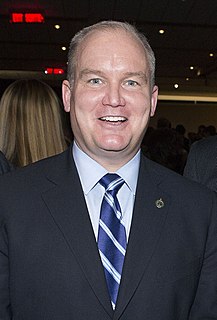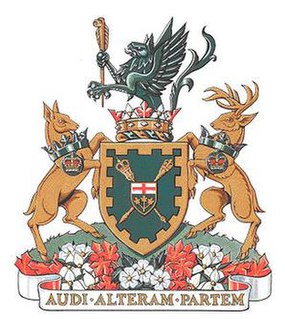Related Research Articles

The United Kingdom is a unitary state with devolution that is governed within the framework of a parliamentary democracy under a constitutional monarchy in which the monarch, currently Queen Elizabeth II, is the head of state while the Prime Minister of the United Kingdom, currently Boris Johnson, is the head of government. Executive power is exercised by the British government, on behalf of and by the consent of the monarch, and the devolved governments of Scotland, Wales and Northern Ireland. Legislative power is vested in the two chambers of the Parliament of the United Kingdom, the House of Commons and the House of Lords, as well as in the Scottish and Welsh parliaments and the Northern Ireland Assembly. The judiciary is independent of the executive and the legislature. The highest court is the Supreme Court of the United Kingdom.

The Bloc Québécois is a federal political party in Canada devoted to Quebec nationalism and the promotion of Quebec sovereignty. The Bloc was formed by Members of Parliament (MPs) who defected from the federal Progressive Conservative Party and Liberal Party during the collapse of the Meech Lake Accord. Founder Lucien Bouchard was a cabinet minister in the federal Progressive Conservative government of Brian Mulroney.

The Scottish Parliament is the devolved, unicameral legislature of Scotland. Located in the Holyrood area of the capital city, Edinburgh, it is frequently referred to by the metonym Holyrood.

The House of Commons of Canada is the lower chamber of the bicameral Parliament of Canada, which also comprises the sovereign and the Senate of Canada. The House of Commons currently meets in a temporary Commons chamber in the West Block of the parliament buildings on Parliament Hill in Ottawa, while the Centre Block, which houses the traditional Commons chamber, undergoes a ten-year renovation.

The Parliament of Canada is the federal legislature of Canada, seated at Parliament Hill in Ottawa, and is composed of three parts: the Monarch, the Senate, and the House of Commons. By constitutional convention, the House of Commons is dominant, with the Senate rarely opposing its will. The Senate reviews legislation from a less partisan standpoint and may initiate certain bills. The monarch or her representative, normally the governor general, provides royal assent to make bills into law.

Stortinget is the supreme legislature of Norway, established in 1814 by the Constitution of Norway. It is located in Oslo. The unicameral parliament has 169 members, and is elected every four years based on party-list proportional representation in nineteen plurinominal constituencies. A member of Stortinget is known in Norwegian as a stortingsrepresentant, literally "Storting representative".
President of the Senate is a title often given to the presiding officer of a senate. It corresponds to the speaker in some other assemblies.

The House of Representatives is the sole chamber of the New Zealand Parliament. The House passes laws, provides ministers to form Cabinet, and supervises the work of government. It is also responsible for adopting the state's budgets and approving the state's accounts.

The prime minister of Hungary is the head of government in Hungary. The Prime Minister and the Cabinet are collectively accountable for their policies and actions to the Parliament, to their political party and ultimately to the electorate. The current holder of the office is Viktor Orbán, leader of the Fidesz – Hungarian Civic Alliance, who has served since 29 May 2010.

The leader of the Official Opposition, formally known as the leader of Her Majesty's Loyal Opposition, is the politician who leads the Official Opposition in Canada, typically the leader of the party possessing the most seats in the House of Commons of Canada that is not the governing party or part of the governing coalition. The current Opposition leader is Erin O'Toole, who took office following his election as leader of the Conservative Party of Canada on August 24, 2020.

The National Assembly of Quebec is the legislative body of the province of Quebec in Canada. Legislators are called MNAs. The Queen in Right of Quebec, represented by the Lieutenant Governor of Quebec and the National Assembly compose the Legislature of Quebec, which operates in a fashion similar to those of other Westminster-style parliamentary systems.
Official party status is the official recognition that the Parliament of Canada and Canada's provincial legislatures grant to some political parties, qualifying them for certain rights and privileges. The qualifications for receiving official party status, usually based on the number of party members in the legislature, varies from legislature to legislature.
In Canada, each political party with representation in the House of Commons has a House Leader who is a front bench Member of Parliament (MP) and an expert in parliamentary procedure. The same representation is found in the provincial and territorial legislatures. The House Leader is in charge of the party's day-to-day business in the House of Commons of Canada, and usually conducts negotiations with other parties on the conduct of bills and debates.
In Canada, Her Majesty's Loyal Opposition, or simply the Official Opposition is usually the largest parliamentary opposition party in the House of Commons of Canada, either on its own or as part of a governing coalition, although, in certain unusual circumstances, it may be a third or fourth-largest party or even the largest party.
The federal government of Canada is the body responsible for the federal administration of Canada. In Canadian English, the term can mean either the collective set of institutions or specifically the Queen-in-Council. In both senses, the current construct was established at Confederation through the Constitution Act, 1867—as a federal constitutional monarchy, wherein the Canadian Crown acts as the core, or "the most basic building block", of its Westminster-style parliamentary democracy. The Crown is thus the foundation of the executive, legislative, and judicial branches of Canadian government. The monarch is personally represented by the Governor General of Canada. The Prime Minister is the head of government who is invited by the Crown to form a government after securing the confidence of the House of Commons, which is typically determined through the election of enough members of a single political party in a federal election to provide a majority of seats in Parliament, forming a governing party. Further elements of governance are outlined in the rest of the Canadian Constitution, which includes written statutes in addition to court rulings, and unwritten conventions developed over centuries.

The Legislative Assembly of Ontario is the Province's legislative chamber that, with the Lieutenant Governor of Ontario, makes up the Legislature of Ontario. The Assembly meets at the Ontario Legislative Building at Queen's Park in the provincial capital of Toronto. Bills passed by the assembly are given royal assent by the Queen, represented by the Lieutenant Governor of Ontario.

The leader of the government in the House of Commons, more commonly known as the government house leader, is the Cabinet minister responsible for planning and managing the government's legislative program in the House of Commons of Canada.

The Parliament of Victoria is the bicameral legislature of the Australian state of Victoria that follows a Westminster-derived parliamentary system. It consists of the Queen, represented by the Governor of Victoria, the Legislative Assembly and the Legislative Council. It has a fused executive drawn from members of both chambers. The parliament meets at Parliament House in the state capital Melbourne. The current Parliament was elected on 24 November 2018, sworn in on 19 December 2018 and is the 59th parliament in Victoria.

The Australian Government is the federal government of Australia, a parliamentary constitutional monarchy, and is the first level of government division. It is also referred to as the Commonwealth Government. Like many other Westminster-style systems of government, the Australian Government is made up of three branches: the executive, the legislative, and the judicial.

The National Assembly is one of the two components of the Parliament of Guyana. Under Article 51 of the Constitution of Guyana, the Parliament of Guyana consists of the President and the National Assembly. The National Assembly has 65 members elected using the system of proportional representation. Twenty five are elected from the ten geographical constituencies and forty are awarded at the national level on the basis of block votes secured, using the LR-Hare Formula as prescribed by the elections Laws (Amendment) Act 15 of 2000.
References
- ↑ Parliamentary offices Archived 2011-05-31 at the Wayback Machine , National Assembly of Quebec, accessed 30 September 2010.
- ↑ "Parliamentary and ministerial office holders". Quebec National Assembly (Assemblée nationale du Québec). 2020. Archived from the original on September 12, 2019. Retrieved January 31, 2020.